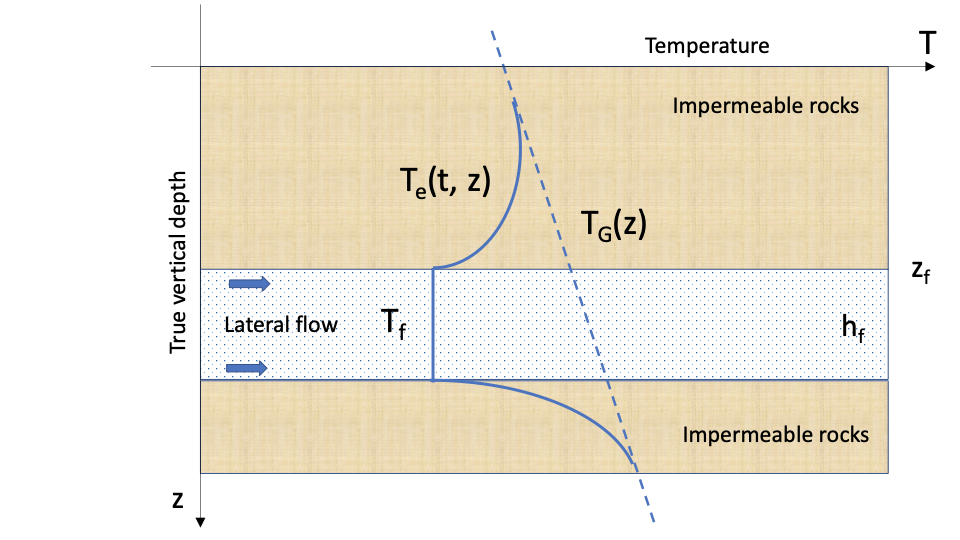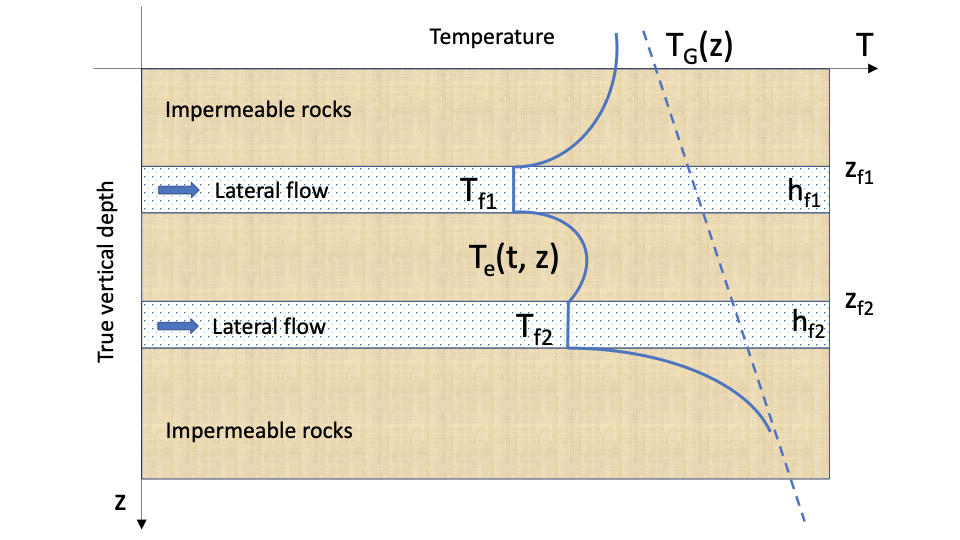Motivation
Subsurface Temperature Profile around Lateral Flow makes adjustments to Geothermal Temperature Profile
to account for the lateral reservoir flow with a constant temperature (see Fig. 1 and Fig. 2).
Outputs
| Subsurface temperature distribution |
Equations
| Driving equation | Initial conditions | Boundary conditions |
|---|
| LaTeX Math Block |
|---|
| \frac{\partial T_e}{\partial t} = a_e^2 \Delta T_e = a_e^2\frac{\partial^2 T_e}{\partial z^2} |
|
| LaTeX Math Block |
|---|
| T_e(t=0, z) = T_G(z) |
|
| LaTeX Math Block |
|---|
| T_e(t, z_f \leq z \leq z_f + h_f) = T_f = {\rm const} |
| LaTeX Math Block |
|---|
| T_e(t, z \rightarrow \infty) = T_G(z) |
|
Solution
| LaTeX Math Block |
|---|
| \mbox{if} \, z < z_f \; \Longrightarrow \;T_e(t,z) = T_f + (T_G(z) - T_f) \cdot \mbox{erf} \left( \frac{z_f-z}{\sqrt{4 a_e t}} \right) |
|
| LaTeX Math Block |
|---|
| \mbox{if} \, z_f \leq z \leq z_f + h_f \; \Longrightarrow \; T_e(t,z) = T_f |
|
| LaTeX Math Block |
|---|
| \mbox{if} \, z > z_f + h_f \; \Longrightarrow \; T_e(t,z) = T_f + (T_G(z) - T_f) \cdot \mbox{erf} \left( \frac{z-z_f-h_f}{\sqrt{4 a_e t}} \right) |
|
where
See Also
Geology / Geothermal Temperature Field / Geothermal Temperature Profile
Physics / Fluid Dynamics / Linear Fluid Flow
[ Temperature Flat Source Solution @model ] [ Geothermal Temperature Profile @model ]
Reference
| Show If |
|---|
|
| Panel |
|---|
|
| Expand |
|---|
| Heat flow equation for Semispace Linear Conduction: | LaTeX Math Block |
|---|
| \frac{\partial T}{\partial t} = a^2 \Delta T = a^2\frac{\partial^2 T}{\partial z^2} |
Initial Conditions | LaTeX Math Block |
|---|
| T(t=0, z) = T_G(z) |
Boundary conditions | LaTeX Math Block |
|---|
| T(t, z=0) = T_f = {\rm const}, \quad T(t, z \rightarrow \infty) = T_G(z) |
The exact solution is given by following formula: | LaTeX Math Block |
|---|
| T(t,z) = T_f + (T_G(z) - T_f) \cdot \frac{2}{\sqrt{\pi}} \int_0^{z/\sqrt{4at}} e^{-\xi^2} d\xi |
A fair approximation at late times ( ) is given by expanding the integral:| LaTeX Math Block |
|---|
| T(t,z) = T_f + (T_G(z) - T_f) \cdot \Bigg[ 1- \frac{\exp(-\zeta^2)}{\sqrt{\pi} \zeta} \bigg( 1- \frac{1}{2 \zeta} + \frac{3}{4 \zeta^3} \bigg) \Bigg] |
where | LaTeX Math Block |
|---|
| \zeta = \frac{z}{4 a t} |
The final solution for temperature above the flowing unit is represented by RHK pipe flow solution where TG is replaced with Tb from | LaTeX Math Block Reference |
|---|
|
.
For the intervals between two injection units the one needs to account for the SLC contribution from upper flowing unit and from lower flowing unit which can be done using the superposition.
First, let's rewrite | LaTeX Math Block Reference |
|---|
|
in terms of temperature gain:| LaTeX Math Block |
|---|
| dT(t, z) = T(t,z) - T_G(z)= - (T_G(z) - T_f) \cdot \frac{\exp(-\zeta^2)}{\sqrt{\pi} \zeta} \bigg( 1- \frac{1}{2 \zeta} + \frac{3}{4 \zeta^3} \bigg) |
Now one can write down the temperature disturbance from the overlying flowing unit A1: | LaTeX Math Block |
|---|
| dT_{b,over}(t, z) = T_{b,up}(t,z) - T_G(z)= - (T_G(z) - T_{f, A1}) \cdot \frac{\exp(-\zeta^2)}{\sqrt{\pi} \zeta} \bigg( 1- \frac{1}{2 \zeta} + \frac{3}{4 \zeta^3} \bigg) |
and from the underlying flowing unit A2: | LaTeX Math Block |
|---|
| dT_{b,under}(t, z) = T_{b,up}(t,z) - T_G(z)= - (T_G(z) - T_{f, A2}) \cdot \frac{\exp(-\zeta^2)}{\sqrt{\pi} \zeta} \bigg( 1- \frac{1}{2 \zeta} + \frac{3}{4 \zeta^3} \bigg) |
The background temperature disturbance between the flowing units will be: | LaTeX Math Block |
|---|
| T_b(t, z) = T_G(z) + dT_{b,over}(t, z) + dT_{b,under}(t, z) |
Replacing the static value of in RHK model with dynamic value of one arrives to the final wellbore temperature model with account of heat exchange with surrounding rocks and cooling effects from flowing units (Semispace Linear Conduction).
|
|
|

